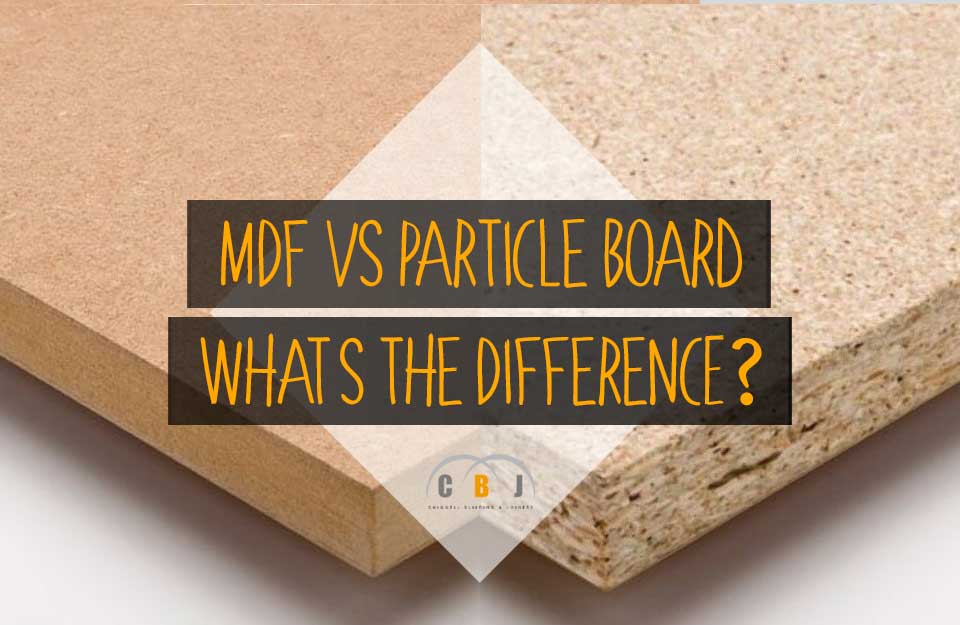
MDF vs Particle Board - What's the Difference
Author Chigwell Building & Joinery
Date 01/02/24
When buying building materials or even purchasing new furniture, you need to consider the quality of the material you choose.
MDF and particle board are among the most popular materials used for various kinds of building projects as well as furniture, since they help to keep prices down.
However, it’s important to be aware of some key differences between the two in order to choose wisely.
Both materials have a similar look but don't quite match up in practical terms.
In the chapters below, we take a look at the key difference between MDF vs particle board, highlighting their pros and cons.
Table of Contents
- What is MDF?
- What is Particle Board?
- Key Differences Between MDF vs Particle Board
- Which is Stronger - MDF vs Particle Board?
- Conclusion
What is MDF?
Image credit: Amazon
MDF stands for Medium Density Fibreboard.
Despite being a by-product of waste wood material, it’s considerably strong and dense.
This is because it is mainly made from wood fibres as opposed to sawdust.
MDF Pros
- Good quality material
- Strong and dense
- Can be painted
- Easy to drill and cut
- Holds screws and nails well
- Smooth surface
- Has a realistic finish
- Does not deteriorate like particle board if exposed to moisture
MDF Cons
- Heavy compared to particle board
- Can release toxic formaldehyde when cut
- More expensive than particle board
- Absorbs water quickly, leading to swelling and damage
What is Particle Board?
Image credit: Wikipedia
Particle board is also known as chipboard or low-density fibreboard.
Like MDF, it is essentially another waste-wood product.
This is because it is made up of byproducts derived from woodwork.
The sawdust gets compressed with resin adhesives to produce sheets of workable material.
Particle boards are used for low-end furniture and home decor projects.
It’s often used for the underlying layer of countertops.
Often laminate or veneer are used to finish the surface of particle boards in order to give it a better look.
Particle Board Pros
- Inexpensive
- Easy to work with
- Holds screws well
- Can be drilled into easily
- Can be cut, painted and glued easily
- Has a smooth and flat surface
- Lightweight and easy to carry or transport
- Ideal for lower end projects
- Easy to clean and maintain
- Made from waste-wood products so eco-friendly
- Good soundproofing properties
Particle Board Cons
- Easily snaps or cracks if bent
- Low durability
- Uneven rough surface
- Not very durable
- Low moisture resistance, leading to expansion problems
Key Differences Between MDF vs Particle Board
One of the main differences between MDF and particle board is that a different amount of material is used to produce them.
MDF is relatively more expensive as it’s stronger and denser than particle board.
This is mainly attributed to the fact that it is made from wood fibres rather than sawdust, as in the case of particle board.
In fact, while particle board has an acceptable level of strength, it’s nowhere near as strong as MDF.
Moreover, it will not stand up to humidity and high levels of moisture as well as MDF.
Despite the fact that they look very similar, MDF does not have any wood grain.
This is due to the fact that it is formed under high pressure and at extreme temperatures, resulting in no voids at all in its composition.
Which is Stronger - MDF vs Particle Board?
There is no denying that MDF is stronger than particle board.
In fact, many like to describe it as being a type of particle board which has been improved.
MDF is an engineered wood that is manufactured using wood fibres which are then bonded together with resin and other adhesives by means of very high compression and temperatures.
On the other hand, particle boards are made similarly but using sawdust.
Hence, MDF is considerably denser and stronger than particle board.
MDF is still not ideal for scenarios with high moisture or humidity, but if sealed at the edges, it will withstand such conditions more than particle board for a certain period of time.
Conclusion
By now you should be in a better position to appreciate the differences between MDF and particle board.
As explained in more detail above, both of them have their respective pros and cons.
Hence, when choosing you will need to take into account their durability, functionality, aesthetic appeal, weight and budget.
This will help you to make a well informed choice depending on your project requirements.

